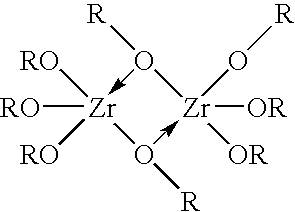Method of synthesizing zirconium phosphate particles
a zirconium phosphate and zirconium phosphate technology, applied in the field of zirconium phosphate particles, can solve the problems of difficult control, lack of appropriate process control methods, and difficult to achieve the precipitation of sol gels on a manufacturing scal
- Summary
- Abstract
- Description
- Claims
- Application Information
AI Technical Summary
Benefits of technology
Problems solved by technology
Method used
Image
Examples
example 1
[0050]A solution of diluted phosphoric acid was made up by mixing 160 gm of 85% orthophosphoric acid with 700 ml deionized water in vessel A. A solution of zirconium oxychloride (ZOC) / sulfate was made up by first dissolving 200 gm of ZOC, in the form of powder crystals, in 120 ml deionized water in vessel B to form a ZOC solution, adding 25 gm of Na2SO4 to the ZOC solution and then agitating to form a clear solution of a zirconium-sulfate complex. Next, 100 ml of the diluted phosphoric acid was transferred from vessel A to a reactor vessel C fitted with an agitator with 3 sets of blades at different levels. With a moderate agitator rate in reactor vessel C, and at room temperature, the rest of the phosphoric acid (from vessel A) and the zirconium-sulfate complex solution (from vessel B) were pumped into reactor vessel C at flow rates of about 23 ml / min and 8.3 ml / min, respectively, via capillary tubings so that the addition and mixing of both components cou...
example 2
Glycerol as Additive
[0051]The steps described in Example 1 were repeated, except that a solution of a zirconium-glycerol complex formed by adding 20 gm glycerol to the ZOC solution was used instead of a solution of a zirconium-sulfate complex. Smooth, oval shaped particles of a particle size in the range 20-40 microns were obtained during the precipitation process. Despite the smaller particle size, there were no problems of flow resistance during filtration and column application of the finished product because of the smooth shape of the particles formed by the emulsification effect of glycerol. Furthermore, upon drying, the hard gel ZrP formed a free-flowing powder without agglomeration. The product samples were tested to have the following properties: a particle size distribution of less than 30% in the range of >60-120 microns, 70% or higher in the range of 30-60 microns, and less than 10% in the range of less than 30 microns, an ammonia capacity of 16-17 mg NH4—N / gm ZP, and an ...
example 3
[0052]The steps described in Example 1 were repeated, except that a solution of a zirconium-carbonate complex formed by adding 25 gm of sodium carbonate to the ZOC solution was used instead of a solution of a zirconium-sulfate complex. The use of sodium carbonate had the same effect on process performance and particle size of product as the use of sodium sulfate in Example 1.
PUM
| Property | Measurement | Unit |
|---|---|---|
| molar ratio | aaaaa | aaaaa |
| temperature | aaaaa | aaaaa |
| temperature | aaaaa | aaaaa |
Abstract
Description
Claims
Application Information
 Login to View More
Login to View More - R&D
- Intellectual Property
- Life Sciences
- Materials
- Tech Scout
- Unparalleled Data Quality
- Higher Quality Content
- 60% Fewer Hallucinations
Browse by: Latest US Patents, China's latest patents, Technical Efficacy Thesaurus, Application Domain, Technology Topic, Popular Technical Reports.
© 2025 PatSnap. All rights reserved.Legal|Privacy policy|Modern Slavery Act Transparency Statement|Sitemap|About US| Contact US: help@patsnap.com



